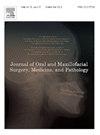Odontogenic keratocyst exhibiting dysplastic changes: Report of a new case in a 14-year-old and literature review
IF 0.4
Q4 DENTISTRY, ORAL SURGERY & MEDICINE
Journal of Oral and Maxillofacial Surgery Medicine and Pathology
Pub Date : 2024-08-03
DOI:10.1016/j.ajoms.2024.08.004
引用次数: 0
Abstract
Odontogenic keratocyst (OKC) is known for its aggressive behavior and a high tendency for recurrence. Malignant transformation in OKC has been widely reported, but comprehensive studies investigating the clinicopathological features and management strategies of dysplastic OKCs are limited. Herein, we report a new case of an OKC exhibiting premalignant changes in a 14-year-old patient and review published cases of dysplastic OKCs. The lesion presented as an incidental radiolucency in the anterior mandible. Histopathological evaluation revealed an intense inflammatory infiltrate in the connective tissue and severe epithelial dysplasia with focal areas exhibiting carcinoma in situ. The dysplastic epithelial lining expressed diffuse reactivity to p53 and displayed a Ki-67 proliferation index of more than 20 %. The lesion was excised by enucleation and thorough curettage. Uneventful healing was noted at the 6-month follow-up appointment. A review of the literature revealed that the average age of diagnosis of dysplastic OKC was 32 years. It showed a preference for the mandible; the most common sites were the anterior and left sides. Most lesions were treated with enucleation; recurrence was reported in one patient. Epithelial dysplasia arising in OKCs is not a frequent finding. A vigilant evaluation of the excised lesions, mainly those displaying significant inflammation, with p53 immunohistochemical analysis may help avoid a misdiagnosis. As OKCs can recur decades after initial treatment, patients with dysplastic lesions should be more closely followed up.
牙源性角化囊肿表现发育不良:14岁新病例报告及文献复习
牙源性角化囊肿(OKC)以其侵略性和高复发倾向而闻名。OKC的恶性转化已被广泛报道,但对发育不良OKC的临床病理特征和治疗策略的综合研究却很有限。在此,我们报告了一个14岁的OKC患者出现癌前病变的新病例,并回顾了已发表的发育不良OKC病例。病变表现为在前下颌骨偶然的放射透光。组织病理学检查显示结缔组织有强烈的炎症浸润和严重的上皮发育不良,局灶区表现为原位癌。增生异常上皮内膜对p53表达弥漫性反应,Ki-67增殖指数超过20%。病变通过去核和彻底刮除切除。在6个月的随访中,我们注意到平稳的愈合。文献回顾显示,发育不良OKC的平均诊断年龄为32岁。它显示了对下颌骨的偏爱;最常见的部位是前部和左侧。大多数病变采用去核治疗;1例复发。上皮异常增生在OKCs中并不常见。警惕地评估切除的病变,主要是那些表现出明显炎症的病变,用p53免疫组织化学分析可能有助于避免误诊。由于OKCs可在初始治疗后数十年复发,因此应更密切地随访患有发育不良病变的患者。
本文章由计算机程序翻译,如有差异,请以英文原文为准。
求助全文
约1分钟内获得全文
求助全文
来源期刊

Journal of Oral and Maxillofacial Surgery Medicine and Pathology
DENTISTRY, ORAL SURGERY & MEDICINE-
CiteScore
0.80
自引率
0.00%
发文量
129
审稿时长
83 days
 求助内容:
求助内容: 应助结果提醒方式:
应助结果提醒方式:


